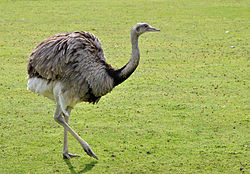| Rheiformes | |
|---|---|
 | |
| Greater rhea (Rhea americana) | |
| Scientific classification | |
| Kingdom: | Animalia |
| Phylum: | Chordata |
| Class: | Aves |
| Infraclass: | Palaeognathae |
| Clade: | Notopalaeognathae |
| Order: | Rheiformes Forbes, 1884 |
| Subgroups [2] | |
| |
Rheiformes is an order that contains the family Rheidae (rheas). [3] It is in the infraclass Paleognathae, which contains all ratites. Extant members are found in South America. While the IOC World Bird List and the Clements Checklist categorise Rheiformes as its own order, [3] [4] the BirdLife Data Zone includes rheas, along with ostriches, tinamous, cassowaries, emu, and kiwis, in the order Struthioniformes. [5] Of the two extant species of rheas recognized by the IUCN Red List, as of 2022 [update] , Rhea americana is listed as near threatened, [6] while Rhea pennata is listed as least concern. [7] From 2014 to 2022, the IUCN recognised Rhea tarapacensis as a separate species, and listed it as near threatened in its last assessment in 2020; [8] in 2022, it was again recognised as a subspecies of R. pennata. [7] : Taxonomy
Today, the order is represented by the sole living genus Rhea , though it contains 4-5 genera in total depending on the affiliation of the extinct genus Diogenornis. The taxonomy of the order is as follows: [9]
Order Rheiformes(Forbes, 1884) Furbringer, 1888 [Rheimorphae Bonaparte, 1849; Rheae Forbes 1884] [10] [11] [12] [13] [14]
- Family Rheidae(Bonaparte 1849) Bonaparte, 1853
- ? Genus † Diogenornis de Alvarenga 1983 (Late Paleocene) – possibly a member of Casuariiformes instead. [2] [9]
- Genus † Heterorhea Rovereto 1914 (Pliocene)
- Genus † Hinasuri Tambussi 1995 (Miocene-Pliocene)
- Genus † Opisthodactylus Ameghino 1895 (Miocene)
- Genus Rhea Brisson 1760 (Miocene-Recent)




